|
    

  
When a gamma-ray photon travels within a detector, the
detector output signal depends on the location of the interactions inside
the detector and the size of the detector.
If the incident gamma-ray energy is above 1022 keV pair
production events can occur, which depending on the size of the detector
mean that
single or double
escape peaks may arise along with the
full
energy peak, the
Compton
continuum
and the
pair
production peak at 511 keV.
 Investigate the effect of the size of the detector by selecting each of the options
below to show the interactions in the detector and the resulting energy
spectrum:
Investigate the effect of the size of the detector by selecting each of the options
below to show the interactions in the detector and the resulting energy
spectrum:
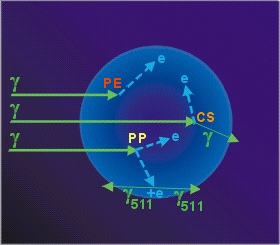 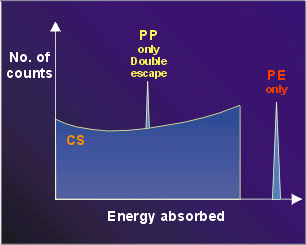 A small detector is one so small that only one interaction can take place within it.
Only the photoelectric effect will produce full energy absorption. Compton scattering events will produce the Compton continuum.
Pair production will give rise to the double escape peak due to both gamma-rays escaping.
A small detector is one so small that only one interaction can take place within it.
Only the photoelectric effect will produce full energy absorption. Compton scattering events will produce the Compton continuum.
Pair production will give rise to the double escape peak due to both gamma-rays escaping.
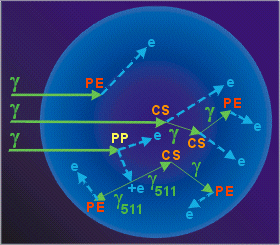 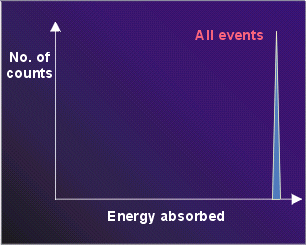 A large detector is one in which we can ignore the surface of the
detector. Various successive photoelectric absorption, Compton
scattering and pair production interactions will occur. The result is
complete absorption of the gamma-ray and a single gamma-ray peak, referred to as the full energy peak.
A large detector is one in which we can ignore the surface of the
detector. Various successive photoelectric absorption, Compton
scattering and pair production interactions will occur. The result is
complete absorption of the gamma-ray and a single gamma-ray peak, referred to as the full energy peak.
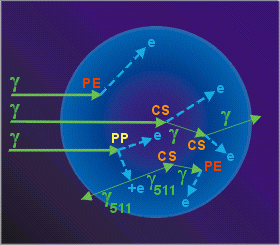 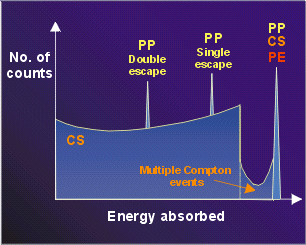 Within a real detector the interaction outcome
is not as simple to predict as the small or large detector case.
Compton scattering may be followed by other Compton scatterings before
the gamma-ray photon escapes from the detector. Also, pair
production may be followed by the loss of only one annihilation gamma-ray, resulting in a single escape peak as well as a double escape peak.
Within a real detector the interaction outcome
is not as simple to predict as the small or large detector case.
Compton scattering may be followed by other Compton scatterings before
the gamma-ray photon escapes from the detector. Also, pair
production may be followed by the loss of only one annihilation gamma-ray, resulting in a single escape peak as well as a double escape peak.
|





